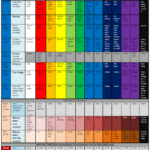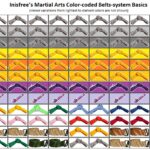Everything from Karate to Jeet Kune Do, Sayoc Kali, and even Dim Mak (a form of acupuncture) is introduced here.
–
Table of Contents:
- Uniform
- Vocabulary
- Years of Basics
- Our Own Style
- Progression
- Belts
- Conceptual Images
–
Uniform:
Inisfreean girls (ICVs) almost always fight naked. They only wear the traditional white gi when they are helping a non-ICV learn a style which includes clothes-grabbing techniques. When the ICVs do martial-arts stances/poses and/or moves in club/dance-settings, there is a diaphanous gi they can wear.
All non-ICV students in this subject are welcome to bring their own gi (made in Inisfree, kept in their closet at their home here in our realm). For this reason, it is common to see gis of different styles and colors in the same class. They do not always reflect the skill-level of the people wearing them; some black gis were chosen by students who just like that color, for example –so always look at the strip of fabric around their waists; their belt in our martial-arts classes does always tell their skill-level.
–
Vocabulary:
- Ate – (AH-tay) – Any technique used as a strike
- Bjj – Brazilian Jiu Jitsu
- Bushido – The ethical code of the warrior
- Chosoku – The ball of the foot
- Dan – (dahn) – “level” such as black belt rank or level of the body
- Do – (doe) – “way” or “lifestyle”, as in “karate-do”(karate way)
- Dojo – ( DOE -joe) – The school, workout area or training hall ” a place to build character”
- Gedan – (Gay-dahn)- The lower body level, from the waist down
- Geri – (GAR-ry) – Any Kick
- Haisoku – The instep of the foot
- Hajime – (HAH-jah-may) – Begin; To start
- Hikite – The pulled back, ready position of the fist, close to the ribs
- Jodan – The upper body level, from the shoulders up
- Kamae – The fighting position of the hands, the fighting place of mind.
- Karate – literal meaning is “empty hand”
- Kata – A series of prearranged techniques executed against imaginary opponents, as a method of practice; Formal exercises
- Kiai – A Vocal expression to aid in the concentration “Ki”of or internal energy. Literal “meeting of Life Energy”
- Kumite – Free Sparring
- Kyu – A belt rank under black belt, or student rank
- Mae – Directed toward the front
- Mate – (MAH-tay) – “I surrender”
- Obi – Belt
- Professor – Bjj Instructor, Teacher, All Bjj Black Belts
- Rei – The command to bow
- Ryu – Style
- Sensei – Teacher, Instructor, Professor, “The one who goes before”
more TBA…
–
Years of Basics:
Students spend an entire year learning and practicing precisely how to punch in all the effective ways. The same amount of time is devoted to mastering the basic appropriate kicks, blocks, throws, dodges, rolls, etc. With this incredible foundation, we move on to more basics; the first templates/”forms”, etc.
Every year, only the most basic elements/components/moves focused on that year are allowed in the daily sparring matches. Free-form/style is not part of sparring until complex masteries are gained and certified.
–
Our Own Styles:
- Tai Chi weaponized
- Tai Chi for seduction/arousal
- all styles combined
…
For reference: lists of all styles of martial arts outside our realm
…
Where the masters help our king practice: the grand dojo of Inisfree.
–
Progression:
General:
- posture
- breathing
- blocks
- strikes/punches
- holds
- kicks
- jumps
- flips
- combos
- identifying an opponent’s style (in order to anticipate their moves, techniques, speed, who taught them, etc.)
- creating one’s own custom sub-style (based on zodiac-year, how one’s own body tends to move/react, etc.)
…
By School-year:
- Balancing
- Rolling
- Falling
- Blocking
- Parrying
- Punching
- Kicking
- Forms
- Pugil Sticks, Spartan Wrestling
- Boxing
- Street Fighting, Grappling, Wrestling
- Jousting, Brazilian Jiu Jitsu, Grappling
- Exodus
- Ninjutsu
- Krav Maga
- Sayoc Kali
–
Belts:
Very much unlike Outlander realms, we don’t have a belts-system for each style of martial arts, all of which are outside our school/s; instead, martial arts is part of the core curriculum of our entire educational system –all the way up from Inisfree’s equivalent of preschool/kindergarten to university life– and each of our grade-levels has its own sequence of color-coded belts to outwardly-indicate skill-level.
1st grade: arm-band color is white this year
- 12 shades of light-gray, from nearly-white… to light-gray, with the 13th belt being black
2nd grade: armband is light gray
- 12 shades of light to medium gray, with the 13th belt being black
3rd: gray armband
- 12 shades of medium to darkest gray, with the 13th belt being black
4th: yellow
- 12 shades of yellow, with the 13th belt being black
5th: orange
- 12 shades of medium to dark orange, with the 13th belt being black
6th: light orange
- 12 shades of light to medium orange, with the 13th belt being black
7th: purple
- 12 shades of medium to dark purple, with the 13th belt being black
8th: lavender
- 12 shades of lavender (light to medium purple), with the 13th belt being black
Grades 9-16: armbands-sequence is dark brown, brown, green, lime green (thus we don’t have 13 shades of any of those as our belts here; earth-tones are reserved for our grade-19 belts-progression), blue, medium blue, and finally: sky blue
- belt-color for month-1 of this school-year: white
- month-2: red
- orange
- yellow
- light green
- green
- cyan/teal
- light blue
- medium-blue
- blue
- indigo
- purple
- final month of this school-year: black
17th grade: based on pussy colors and feminine colors
- white
- pale pink
- light pink
- pink
- medium pink
- dark pink
- rose
- dark rose
- light crimson
- crimson
- red-brown
- darker red-brown
- darkest red-brown
18th: based on human skin-tones
- white
- barely sun-kissed; pale
- slightly tan
- mildly tan
- somewhat tan
- tan
- tanner
- tannest before bronzed
- bronzed
- light brown
- brown
- dark brown
- black
19: based on common camouflage colors
- pale dusty green
- light green (not lime)
- green
- medium green
- forest green
- dark green
- gray
- dark gray
- light brown
- brown
- medium-dark brown
- dark brown
- black
20th grade; the final in our system: same belt-color the entire year; the pussy-pink colored one
Since our martial arts training combines all styles, and focuses on 1 style each month, and allows belt-progression once each month, our belt-colors do not represent skill-levels within one style, but experience with an entire style.
We teach the styles in order of difficulty.
This is why jiujitsu and wrestling earn white belts, while gun katas and ninjutsu are at the other end of this spectrum; they earn black belts.
The first image shows the partially-outdated original/draft belt-colors system; now, many Batchling grade-levels have a sequence of colored belts based on the armband they wear each of those years. The reason our belt-colors system got updated in 2023 is because the document in which it was originally drafted a decade or so ago… was simply a file format / program which didn’t have many colors available to paint its chart fields, thus the few it had… were alternated/repeated. Now we have much better.
…
2023 October note: ICVs are naked except for their colored rank-belt.
–
Conceptual Images:
–
Also see:
- slide nudge stance technique
- 3 weapons – Kristian Andersen
- many fake/weak kicks to pads, but good ass-jiggle bold-stance, pardon her retarded lie-caption about PTSD
–



